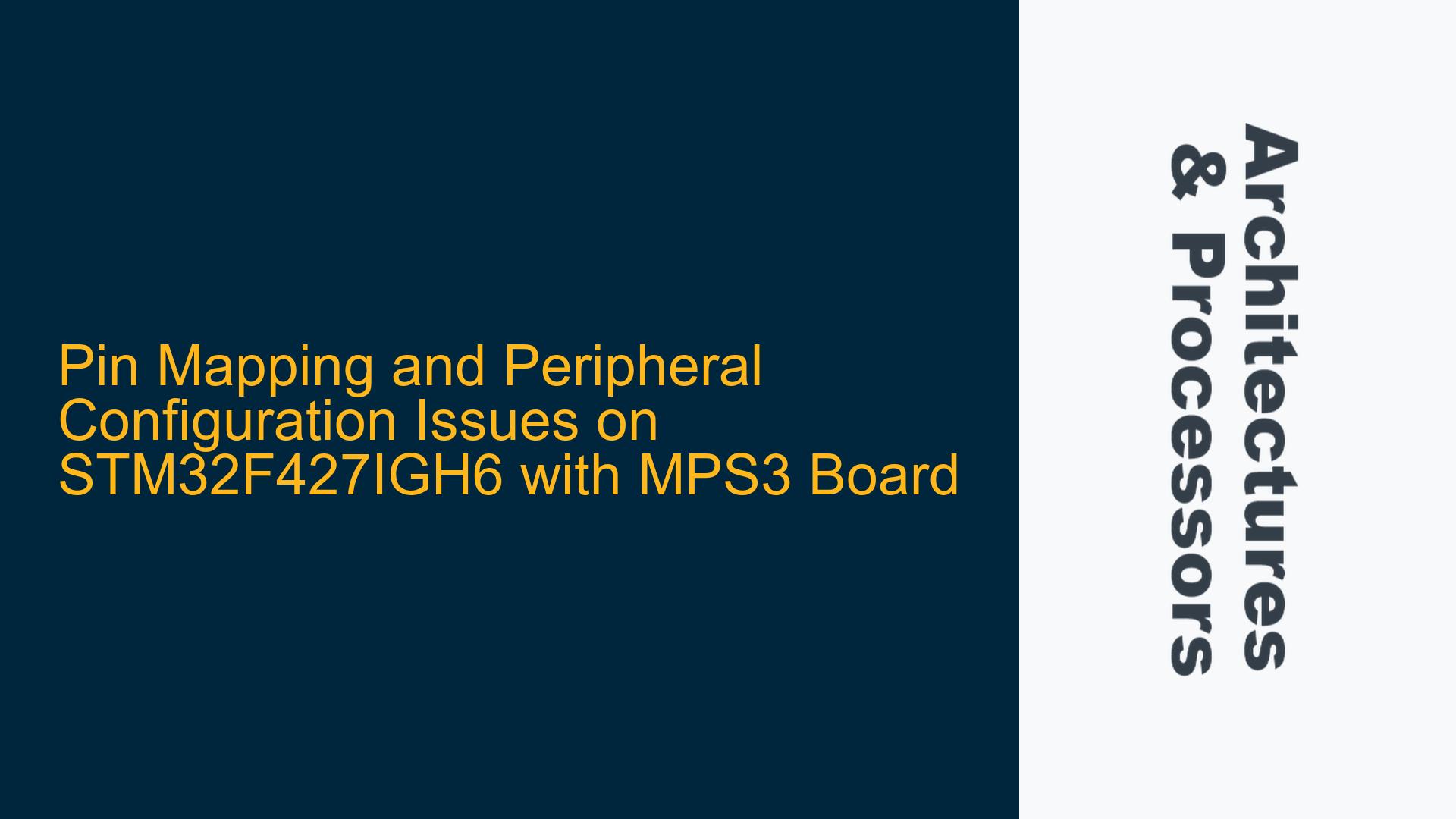STM32F427IGH6 Pin-to-Peripheral Mapping Challenges on MPS3
The STM32F427IGH6 microcontroller, when used with the ARM MPS3 development board, presents a unique challenge in mapping its internal peripherals to the physical pins of the board. This issue arises due to the lack of clear documentation that directly correlates the STM32F427IGH6’s pin functions with the MPS3 board’s interface. Specifically, engineers are struggling to map internal peripheral signals such as UART receive interrupts (e.g., UARTRX0_IRQn) to the corresponding physical pins on the STM32F427IGH6. This problem is compounded by the fact that the MPS3 board is primarily an FPGA prototyping platform, which introduces additional layers of abstraction between the microcontroller and the physical I/O.
The STM32F427IGH6 datasheet provides detailed information about the microcontroller’s pinout and alternate functions, but it does not explicitly address how these pins interface with the MPS3 board. Furthermore, the CMSDK_IoT.h header file, which defines interrupt numbers for the Cortex-M3 processor, does not align with the STM32F427IGH6’s interrupt mapping. This discrepancy creates confusion when attempting to configure peripherals such as UART, GPIO, or timers for manual I/O control.
The core of the issue lies in the absence of a unified document or schematic that bridges the gap between the STM32F427IGH6’s internal architecture and the MPS3 board’s physical layout. Engineers are left to piece together information from multiple sources, including the STM32F427IGH6 datasheet, the MPS3 board schematic, and the CMSIS documentation. This process is time-consuming and error-prone, especially when dealing with complex peripherals like DMA controllers or communication interfaces.
Mismatched Interrupt Mapping and Lack of Unified Documentation
The primary cause of the pin mapping confusion stems from the mismatch between the interrupt definitions in the CMSDK_IoT.h header file and the STM32F427IGH6’s actual interrupt mapping. The CMSDK_IoT.h file, designed for the Cortex-M3 processor, defines interrupt numbers such as UARTRX0_IRQn, which do not directly correspond to the STM32F427IGH6’s interrupt vector table. The STM32F427IGH6 uses a different numbering scheme for its UART interrupts, typically labeled as USART1_IRQn, USART2_IRQn, and so on. This discrepancy makes it difficult to map the CMSIS-defined interrupts to the STM32F427IGH6’s physical pins.
Another contributing factor is the lack of a unified document that maps the STM32F427IGH6’s pins to the MPS3 board’s interface. While the STM32F427IGH6 datasheet provides detailed pinout information, it does not specify how these pins connect to the MPS3 board. Similarly, the MPS3 board schematic does not provide a clear mapping of the STM32F427IGH6’s pins to its physical connectors. This gap in documentation forces engineers to manually trace connections between the microcontroller and the board, which is both tedious and prone to errors.
Additionally, the MPS3 board’s FPGA-based architecture introduces another layer of complexity. The FPGA acts as an intermediary between the STM32F427IGH6 and the board’s physical I/O, which means that the microcontroller’s pins may not directly correspond to the board’s connectors. This indirect connection requires engineers to understand both the STM32F427IGH6’s pin functions and the FPGA’s configuration, further complicating the pin mapping process.
Resolving Pin Mapping and Peripheral Configuration Issues
To address the pin mapping and peripheral configuration challenges, engineers must take a systematic approach that combines information from multiple sources. The first step is to thoroughly review the STM32F427IGH6 datasheet, focusing on the pinout and alternate function tables. These tables provide detailed information about each pin’s capabilities, including its default function, alternate functions, and associated peripherals. By cross-referencing this information with the MPS3 board schematic, engineers can begin to map the STM32F427IGH6’s pins to the board’s physical connectors.
Next, engineers should examine the CMSDK_IoT.h header file and compare its interrupt definitions with the STM32F427IGH6’s interrupt vector table. This comparison will reveal any discrepancies between the two, allowing engineers to create a mapping between the CMSIS-defined interrupts and the STM32F427IGH6’s actual interrupts. For example, if the CMSDK_IoT.h file defines UARTRX0_IRQn as interrupt number 10, but the STM32F427IGH6 uses USART1_IRQn for the same purpose, engineers must adjust their code accordingly.
Once the pin and interrupt mappings are established, engineers can proceed with configuring the STM32F427IGH6’s peripherals. This process involves setting up the appropriate GPIO modes, alternate functions, and clock configurations for each peripheral. For example, to configure a UART peripheral, engineers must enable the corresponding GPIO pins in alternate function mode, configure the UART baud rate and data format, and enable the necessary interrupts.
To ensure reliable operation, engineers should also consider the electrical characteristics of the STM32F427IGH6’s pins and the MPS3 board’s interface. This includes verifying that the pin voltages, drive strengths, and pull-up/pull-down resistors are compatible with the board’s requirements. Additionally, engineers should test their configurations using a combination of software debugging tools and hardware probes to verify that the peripherals are functioning as expected.
Finally, engineers should document their findings and create a comprehensive pin mapping table that correlates the STM32F427IGH6’s pins with the MPS3 board’s connectors. This table should include information about each pin’s default function, alternate functions, associated peripherals, and any special considerations (e.g., voltage levels, drive strengths). By creating this documentation, engineers can streamline future development efforts and reduce the likelihood of errors.
In summary, resolving the pin mapping and peripheral configuration issues on the STM32F427IGH6 with the MPS3 board requires a combination of thorough documentation review, careful cross-referencing, and systematic testing. By following these steps, engineers can successfully map the microcontroller’s pins to the board’s physical connectors and configure the necessary peripherals for manual I/O control.






